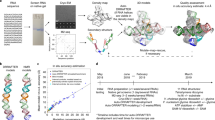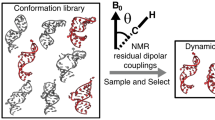Abstract
Molecular modeling guided by experimentally derived structural information is an attractive approach for three-dimensional structure determination of complex RNAs that are not amenable to study by high-resolution methods. Hydroxyl radical probing (HRP), which is performed routinely in many laboratories, provides a measure of solvent accessibility at individual nucleotides. HRP measurements have, to date, only been used to evaluate RNA models qualitatively. Here we report the development of a quantitative structure refinement approach using HRP measurements to drive discrete molecular dynamics simulations for RNAs ranging in size from 80 to 230 nucleotides. We first used HRP reactivities to identify RNAs that form extensive helical packing interactions. For these RNAs, we achieved highly significant structure predictions given the inputs of RNA sequence and base pairing. This HRP-directed tertiary structure refinement approach generates robust structural hypotheses that are useful for guiding explorations of structure-function inter-relationships in RNA.
This is a preview of subscription content, access via your institution
Access options
Subscribe to this journal
Receive 12 print issues and online access
$259.00 per year
only $21.58 per issue
Buy this article
- Purchase on Springer Link
- Instant access to full article PDF
Prices may be subject to local taxes which are calculated during checkout



Similar content being viewed by others
References
Gesteland, R.F., Cech, T.R. & Atkins, J.F. eds. The RNA World: The Nature of Modern RNA Suggests a Prebiotic RNA World. (Cold Spring Harbor Lab Press, Plainview, NY, 2006).
Das, R. & Baker, D. Automated de novo prediction of native-like RNA tertiary structures. Proc. Natl. Acad. Sci. USA 104, 14664–14669 (2007).
Ding, F. et al. Ab initio RNA folding by discrete molecular dynamics: from structure prediction to folding mechanisms. RNA 14, 1164–1173 (2008).
Parisien, M. & Major, F. The MC-Fold and MC-Sym pipeline infers RNA structure from sequence data. Nature 452, 51–55 (2008).
Cao, S. & Chen, S.J. Physics-based de novo prediction of RNA 3D structures. J. Phys. Chem. B 115, 4216–4226 (2011).
Das, R. et al. Structural inference of native and partially folded RNA by high-throughput contact mapping. Proc. Natl. Acad. Sci. USA 105, 4144–4149 (2008).
Yu, E.T., Hawkins, A., Eaton, J. & Fabris, D. MS3D structural elucidation of the HIV-1 packaging signal. Proc. Natl. Acad. Sci. USA 105, 12248–12253 (2008).
Gherghe, C.M. et al. Native-like RNA tertiary structures using a sequence-encoded cleavage agent and refinement by discrete molecular dynamics. J. Am. Chem. Soc. 131, 2541–2546 (2009).
Jonikas, M.A. et al. Coarse-grained modeling of large RNA molecules with knowledge-based potentials and structural filters. RNA 15, 189–199 (2009).
Lavender, C.A., Ding, F., Dokholyan, N.V. & Weeks, K.M. Robust and generic RNA modeling using inferred constraints: a structure for the hepatitis C virus IRES pseudoknot domain. Biochemistry 49, 4931–4933 (2010).
Yang, S., Parisien, M., Major, F. & Roux, B. RNA structure determination using SAXS data. J. Phys. Chem. B 114, 10039–10048 (2010).
Michel, F. & Westhof, E. Modelling of the three-dimensional architecture of group I catalytic introns based on comparative sequence analysis. J. Mol. Biol. 216, 585–610 (1990).
Gutell, R.R. et al. Identifying constraints on the higher-order structure of RNA: continued development and application of comparative sequence analysis methods. Nucleic Acids Res. 20, 5785–5795 (1992).
Deigan, K.E., Li, T.W., Mathews, D.H. & Weeks, K.M. Accurate SHAPE-directed RNA structure determination. Proc. Natl. Acad. Sci. USA 106, 97–102 (2009).
Weeks, K.M. Advances in RNA structure analysis by chemical probing. Curr. Opin. Struct. Biol. 20, 295–304 (2010).
Hajdin, C.E., Ding, F., Dokholyan, N.V. & Weeks, K.M. On the significance of an RNA tertiary structure prediction. RNA 16, 1340–1349 (2010).
Bailor, M.H., Mustoe, A.M., Brooks, C.L. III & Al-Hashimi, H.M. Topological constraints: using RNA secondary structure to model 3D conformation, folding pathways, and dynamic adaptation. Curr. Opin. Struct. Biol. 21, 296–305 (2011).
Tullius, T.D. & Greenbaum, J.A. Mapping nucleic acid structure by hydroxyl radical cleavage. Curr. Opin. Chem. Biol. 9, 127–134 (2005).
Cate, J.H. et al. Crystal structure of a group I ribozyme domain: principles of RNA packing. Science 273, 1678–1685 (1996).
Pastor, N., Weinstein, H., Jamison, E. & Brenowitz, M. A detailed interpretation of OH radical footprints in a TBP-DNA complex reveals the role of dynamics in the mechanism of sequence-specific binding. J. Mol. Biol. 304, 55–68 (2000).
Bergman, N.H. et al. The three-dimensional architecture of the class I ligase ribozyme. RNA 10, 176–184 (2004).
Rangan, P., Masquida, B., Westhof, E. & Woodson, S.A. Assembly of core helices and rapid tertiary folding of a small bacterial group I ribozyme. Proc. Natl. Acad. Sci. USA 100, 1574–1579 (2003).
Dokholyan, N.V., Buldyrev, S.V., Stanley, H.E. & Shakhnovich, E.I. Discrete molecular dynamics studies of the folding of a protein-like model. Fold. Des. 3, 577–587 (1998).
Dann, C.E. III et al. Structure and mechanism of a metal-sensing regulatory RNA. Cell 130, 878–892 (2007).
Balasubramanian, B., Pogozelski, W.K. & Tullius, T.D. DNA strand breaking by the hydroxyl radical is governed by the accessible surface areas of the hydrogen atoms of the DNA backbone. Proc. Natl. Acad. Sci. USA 95, 9738–9743 (1998).
Berman, H.M. et al. The Protein Data Bank. Nucleic Acids Res. 28, 235–242 (2000).
Westhof, E., Dumas, P. & Moras, D. Restrained refinement of 2 crystalline forms of yeast aspartic-acid and phenylalanine transfer-RNA crystals. Acta Crystallogr. A 44, 112–123 (1988).
Serganov, A. et al. Structural basis for gene regulation by a thiamine pyrophosphate-sensing riboswitch. Nature 441, 1167–1171 (2006).
Krasilnikov, A.S., Yang, X., Pan, T. & Mondragon, A. Crystal structure of the specificity domain of ribonuclease P. Nature 421, 760–764 (2003).
Adams, P.L. et al. Crystal structure of a self-splicing group I intron with both exons. Nature 430, 45–50 (2004).
Cochrane, J.C., Lipchock, S.V., Smith, K.D. & Strobel, S.A. Structural and chemical basis for glucosamine 6-phosphate binding and activation of the glmS ribozyme. Biochemistry 48, 3239–3246 (2009).
Serganov, A., Huang, L. & Patel, D.J. Structural insights into amino acid binding and gene control by a lysine riboswitch. Nature 455, 1263–1267 (2008).
Kazantsev, A.V., Krivenko, A.A. & Pace, N.R. Mapping metal-binding sites in the catalytic domain of bacterial RNase P RNA. RNA 15, 266–276 (2009).
Toor, N. et al. Tertiary architecture of the Oceanobacillus iheyensis group II intron. RNA 16, 57–69 (2010).
Milligan, J.F., Groebe, D.R., Witherell, G.W. & Uhlenbeck, O.C. Oligoribonucleotide synthesis using T7 RNA polymerase and synthetic DNA templates. Nucleic Acids Res. 15, 8783–8798 (1987).
Merino, E.J., Wilkinson, K.A., Coughlan, J.L. & Weeks, K.M. RNA structure analysis at single nucleotide resolution by Selective 2′-Hydroxyl Acylation and Primer Extension (SHAPE). J. Am. Chem. Soc. 127, 4223–4231 (2005).
Duncan, C.D.S. & Weeks, K.M. The Mrs1 splicing factor binds the bI3 group I intron at each of two tetraloop-receptor motifs. PLoS One 5, e8983 (2010).
Murphy, F.L. & Cech, T.R. An independently folding domain of RNA tertiary structure within the Tetrahymena ribozyme. Biochemistry 32, 5291–5300 (1993).
Latham, J.A. & Cech, T.R. Defining the inside and outside of a catalytic RNA molecule. Science 245, 276–282 (1989).
Klein, D.J., Been, M.D. & Ferre-D'Amare, A.R. Essential role of an active-site guanine in glmS ribozyme catalysis. J. Am. Chem. Soc. 129, 14858–14859 (2007).
McGinnis, J.L., Duncan, C.D. & Weeks, K.M. High-throughput SHAPE and hydroxyl radical analysis of RNA structure and ribonucleoprotein assembly. Methods Enzymol. 468, 67–89 (2009).
Vasa, S.M. et al. ShapeFinder: a software system for high-throughput quantitative analysis of nucleic acid reactivity information resolved by capillary electrophoresis. RNA 14, 1979–1990 (2008).
Acknowledgements
We thank E.A. Proctor, R. Redler and S. Ramachandran for critical readings of the manuscript. This work was supported by grants from the US National Institutes of Health to K.M.W. (GM064803) and N.V.D. (GM080742 and CA084480), by a US National Institutes of Health American Recovery and Reinvestment Act supplement (to K.M.W.) and by the University of North Carolina Research Council (to F.D.).
Author information
Authors and Affiliations
Contributions
F.D., K.M.W. and N.V.D. conceived of and designed the computational and experimental procedures. C.A.L. performed and analyzed the HRP measurements. F.D. developed the computational methodology and performed the computational analysis. F.D., C.A.L., K.M.W. and N.V.D. wrote the manuscript.
Corresponding authors
Ethics declarations
Competing interests
The authors declare no competing financial interests.
Supplementary information
Supplementary Text and Figures
Supplementary Figures 1–7, Supplementary Tables 1 and 2 (PDF 4812 kb)
Supplementary Dataset
The HRP reactivities and interaction parameters for all RNAs (XLS 284 kb)
Rights and permissions
About this article
Cite this article
Ding, F., Lavender, C., Weeks, K. et al. Three-dimensional RNA structure refinement by hydroxyl radical probing. Nat Methods 9, 603–608 (2012). https://doi.org/10.1038/nmeth.1976
Received:
Accepted:
Published:
Issue Date:
DOI: https://doi.org/10.1038/nmeth.1976
This article is cited by
-
Zinc-finger protein CNBP alters the 3-D structure of lncRNA Braveheart in solution
Nature Communications (2020)
-
Structural interpretation of DNA–protein hydroxyl-radical footprinting experiments with high resolution using HYDROID
Nature Protocols (2018)
-
High-throughput determination of RNA structures
Nature Reviews Genetics (2018)
-
Progress and challenges for chemical probing of RNA structure inside living cells
Nature Chemical Biology (2015)
-
Determination of in vivo RNA structure in low-abundance transcripts
Nature Communications (2013)



